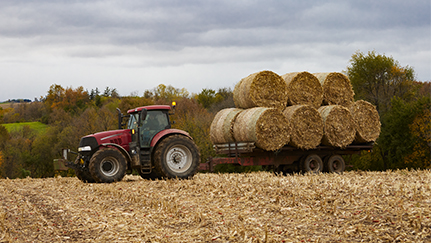Hundreds of barn fires happen every year in the U.S. And in many of them, hay bales are the fuel source for what’s almost always a major property loss that also can endanger livestock and farm workers.
Hay bale fires can happen from the day the bales are made until they’re used, regardless of the forage type or quality. In most cases, wet hay is actually more likely to catch fire or spontaneously combust than dry hay. Hay fires are a unique, costly hazard that calls for year-round attention, according to Nationwide Risk Management Consultant, agronomist and Iowa farmer Derek Hommer.
“Hay bale fires are just one type that contributes to fire being the leading cause of farm claims and losses,” Hommer said. “That’s why it’s so important pay close attention to nearby heat sources, hay moisture and bale quality. They all contribute to how hay catches fires and potential spontaneous combustion.”
Why does wet hay catch on fire?
When harvested at a higher moisture level, a forage crop sometimes stays damp and respires well after baling. That continued respiration in the presence of oxygen after it’s baled creates conditions that can cause bales to spontaneously combust. Wet hay that continues to respire can generate heat and eventually spontaneously combust.
After hay is baled and stored at higher moisture levels, the fire risk from spontaneous combustion is greatest in the first two to six weeks. And that risk continues if hay bales are stored where moisture can linger, like a barn with a leaky roof or high-humidity area.
“Hay placed in storage should have a moisture content under 25%,” according to a university report from The Pennsylvania State University Agriculture and Biological Engineering Department. “Higher levels of moisture require an oxygen limiting storage system. The heat generated by the crop plus the presence of oxygen increases the risk of a fire.”
Key times to think about hay bale fire prevention
Hommer recommends the following best practices throughout the growing season to minimize hay bale fire risk, especially from spontaneous combustion once bales are stored:
- Harvesting. Harvest forage within the optimal moisture range and allow adequate drying time in the field before baling.
- Conditioning. Mower conditioners, tedders and rakes can speed hay drying but can also harm leaf retention and crop quality.
- Baling. Bale hay up to 20% moisture to reduce the potential for hay bales spontaneously combusting or spoiling.
- Storing. Since moisture contributes to bale heating and fires, store hay under a roof to keep it as dry as possible. Hay probes and sensors like in the HAYTECH platform helps monitor temperatures in stored hay that can help prevent hay fires or spontaneously combusting bales.
Additional hay bale fire hazards
Hay bale fires can create other hazards. Hollow cavities can develop inside burning hay bales, creating entrapment hazards for workers. Such smoldering can also generate toxic gases.
“There are hay bale fire hazards beyond spontaneous combustion. If you notice any unusual odors, look for smoke or any smoldering in bales before resuming work,” Hommer said. “If you remove smoldering hay, be careful. The resulting increased ventilation can cause a sudden flareup.”
If you have questions about preventing hay bale fires on your operation, talk to your Nationwide Farm Certified agent or local Extension forage specialist.
